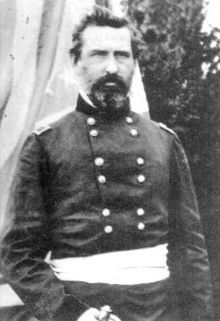William T. H. Brooks
William T. H. Brooks | |
|---|---|
 Maj. Gen. William T. H. Brooks | |
| Born | January 28, 1821 New Lisbon, Ohio |
| Died | July 19, 1870 (aged 49) Huntsville, Alabama |
| Place of burial | Maple Hill Cemetery, Huntsville, Alabama |
| Allegiance | Union |
| Service/ | United States Army Union Army |
| Years of service | 1841–1864 |
| Rank | |
| Unit | Army of the Potomac |
| Commands held | 2nd Brigade, 2nd Division, VI Corps Department of the Monongahela 1st Division/XVIII Corps |
| Battles/wars | Second Seminole War Mexican War American Civil War |
| Other work | farmer |
William Thomas Harbaugh Brooks (January 28, 1821 – July 19, 1870) was a career military officer in the United States Army, serving as a major general during the American Civil War.
Early life
Brooks was born in New Lisbon (now Lisbon), Ohio, and was educated in public schools. He graduated from the United States Military Academy, ranking 46th out of 52 students in the Class of 1841. Appointed a second lieutenant, he served on garrison and frontier duty.
Seminole and Mexican Wars
Brooks saw combat in both the
He was promoted to captain,
Civil War
With the outbreak of the Civil War, Brooks was appointed
Promoted to divisional command, Brooks led the 1st Division of VI Corps at
Battle
April 29, 1863: Second Battle of Fredericksburg
Maj. Gen. John Sedgwick was left near Fredericksburg with the VI Corps, the I Corps, and the II Corps division of Brig. Gen. John Gibbon. Hooker's plan called for Sedgwick to demonstrate near the city in order to deceive Lee about the Union plan. The VI and II Corps seized control of several crossings on April 29, 1863 laying down pontoon bridges in the early morning hours, and the divisions of William T. H. Brooks and James S. Wadsworth crossed the river. The I Corps was ordered to reinforce the main army at Chancellorsville during the night of May 1. During the evening of May 2, 1863 Sedgwick received orders to attack Early with his remaining forces.[2]
May 3, 1863: Fredericksburg and Salem Church
At 7 a.m. on May 3, Early was confronted with four Union divisions: Brig. Gen. John Gibbon of the II Corps had crossed the Rappahannock north of town, and three divisions of Sedgwick's VI Corps—Maj. Gen. John Newton and Brig. Gens. Albion P. Howe and William T. H. Brooks — were arrayed in line from the front of the town to Deep Run. Most of Early's combat strength was deployed to the south of town, where Federal troops had achieved their most significant successes during the December battle. Marye's Heights was defended by Barksdale's Mississippi brigade and Early ordered the Louisiana brigade of Brig. Gen. Harry T. Hays from the far right to Barksdale's left.[3]
May 3, 1863: Battle of Salem Church
At first Sedgwick believed that he faced a single brigade of infantry, so about 3:30 p.m. he attacked the Confederate positions with only William T. H. Brooks division. Brooks succeeded in driving back McLaws's right flank but a counterattack stopped the Union attack and forced Brooks to retreat back to his original position; sunset ended the combat before any further units were involved. During the night, Lee ordered Early to attack Sedgwick's left flank in the morning, while McLaws attacked the Union right.[4] Also during the night, Sedgwick received no further orders from Hooker other than authorization to retreat across the river if Sedgwick thought the move was necessary.[5]
Retirement and death
After the war, Brooks retired to Alabama and established a farm. He died in Huntsville, Alabama, and is buried there in Maple Hill Cemetery.
See also
Notes
References
- Eicher, John H., and ISBN 0-8047-3641-3.
- Aztec Club biography
- Military biography of Brooks from the Cullum biographies
- Second Battle of Fredericksburg Second Battle of Fredericksburg
- Fredericksburg Union order of battle, VI Corps
- Battle of Salem Church Battle of Salem Church
